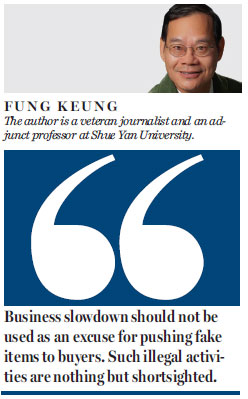Retailers and officers must join forces to target fake goods
Updated: 2015-12-29 07:48
By Fung keung(HK Edition)
|
|||||||
Government officials and Hong Kong Retail Management Association (HKRMA) executives should join hands in cracking down on sales of counterfeit goods in local shops.
The sale of fake goods has jeopardized Hong Kong's status as a shopping paradise for tourists, particularly those from the mainland. Our compatriots from across the Shenzhen River come to shop in Hong Kong because they trust our retailers' integrity.
The real picture, however, is not a happy one. From January to November, Hong Kong's customs officers seized counterfeit goods totaling HK$85 million, a 20 percent rise from the same period a year earlier. December figures are not available yet.
The trend is worrying and measures must be taken urgently to curb the surge in the sale of fake products. Our customs and excise officers are doing a good job in detecting and investigating shops that sell counterfeit goods and making arrests. It is hoped that the HKRMA, with about 7,800 member outlets, can be more proactive in policing their members and reporting those who break the law to the Customs and Excise Department. It is good for the industry and Hong Kong as a whole. Protecting Hong Kong's shopping-paradise image is everybody's job.
On Dec 18, customs and excise officers raided a shop in Admiralty Centre, seizing more than 600 counterfeit items valued at HK$1 million. Items confiscated included women's leather handbags, shoes and accessories of famous brands. The fake items were being sold at prices 30 percent to 60 percent below those of genuine products.
The shop-owner and a salesperson were arrested. According to Hong Kong law, the maximum penalty for selling or possessing for sale counterfeit items is a fine of HK$500,000 and five years in jail. Almost all offenders, however, get away with a small fine. It's time our judges became harsher in delivering sentences to discourage retailers from pitching fake goods to locals and tourists. Judges then would be doing a great job in helping protect Hong Kong's unsoiled image.
About a month earlier on Nov 3, customs officers cracked down on an upstairs showroom in Causeway Bay and seized 900 items of counterfeit goods including ladies' apparel and leather products. Three people were arrested and released on bail.
It is hardly a secret that many counterfeit products come from the mainland. For example, in November, the Yiwu market supervision and administration department in Zhejiang province raided a building used to store counterfeit sports shoes. Officers seized 1,200 pairs of fake Nike shoes and 1,480 pairs of fake Adidas shoes. The Customs and Excise Department is well-advised to beef up inspection at border crossings in Lo Wu and Lok Ma Chau, among others.
The fact that counterfeit items seized saw a 20 percent rise in the first 11 months of this year probably has something to do with the local economy. Hong Kong's GDP grew 2.3 percent in the third quarter of 2015, slower than the 2.8 percent growth posted in the second quarter. Meanwhile, year-on-year retail sales in value terms fell 5.3 percent in August, 6.3 percent in September and 3 percent in October.
Business slowdown should not be used as an excuse for pushing fake items to buyers. Such illegal activities are nothing but shortsighted. Retailers should try to cut costs and diversify their businesses. They may end up in jail for cutting corners.
Some retailers may still cut corners to make a fast buck. It is the job of Hong Kong government officials and the HKRMA to work closely in getting rid of retailers who unashamedly continue to sell counterfeit goods in local shops.

(HK Edition 12/29/2015 page9)